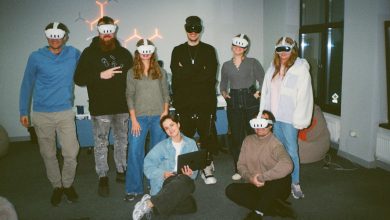The vast and yet undefined metaverse sparkles with opportunity for many businesses. But this exciting immersive future would not be possible without highly evolved and optimised data infrastructures – or the technological innovation that paved the way for it.
So, as we ponder the opportunities of tomorrow, let’s pay homage to the enterprise tech developments that enabled this journey. Decoding the digital timeline with a dose of nostalgia takes us from the once fabulous office fax to smartphones.
Beneath today’s technologies
We stand at a key moment in the Fourth Industrial Revolution – when innovative technologies are maturing, hastening the pace of digital adoption. Cloud infrastructure, edge computing, AI and automation are enabling the seamless integration of technology with our everyday lives. Our once imagined futures brought to life in sci-fi classics from Star Trek’s Communicator to the Jetson’s video calls are now a reality.
But beneath the shiny creativity and imagination fuelled innovation, lies some fairly hardcore technologies – and equally determined technologists. Lift the hood and you will find the foundational data-driven technologies that make today’s tech seamless. They are the unsung heroes of our progress.
Take AI and automation, the faceless technology – contrary to popular culture’s humanoid depictions – is embedded within devices and software packages providing benefits barely registered by the average consumer. It delivers real-time weather reports, highlights important emails, and transforms business prospects with powerful insights.
This is all supported by data centres and network optimisations, enabling the always-on services we now expect – and empowering businesses to think bigger. When uptime is guaranteed they can deliver customer-centric experiences, reliable products, and previously unimagined services. But of course, this is all underpinned by connectivity which galvanises our digital futures and opens the digital opportunity for all.
Celebrating yesterday’s tech transformations
As we soak in the nectar of this incredible sweet spot, we must acknowledge the patience and tenacity of the technologists and engineers that paved the way for us. Their game-changing inventions have transformed the way we live and work together – many hype cycles after their initial launch.
It may be surprising to learn that the beloved office fax started a business revolution as early as 1924. While the ability to send images and text over wire had been around for some time, Richard H. Ranger’s photoradiogram was the first machine able to send images wirelessly. In 1924 it transmitted an image of President Calvin Coolidge from New York to London, changing business communications forever.
Just three years later a 21-year-old Philo T. Farnsworth invented the television, kick-starting a new age of moving image and mass communication. But it wasn’t until the 1940s that colour TV became commercially viable, beaming news, entertainment and adverts into the nation’s living rooms. That’s where it stayed until the early noughties when video met the World Wide Web and live streaming platforms took off from 2005.
In the meantime, the old ‘dog and bone’ has been around since Alexander Bell patented the device in 1876. He could never have imagined how his telephone would transform communication almost 150 years later. While landline services evolved – connecting cities to suburbs, rural regions and eventually far-flung continents – it wasn’t until 1984 that telephones went cellular. But the concept descended from the two-way radiophones that helped police and military personnel to stay in contact in fast-changing situations since before the Second World War.
Converging technologies
Inspired by the Star Trek Communicator and the desire to connect people, Motorola engineer Martin Cooper developed the first hand-held phone. It could connect over the Advanced Mobile Phone System (AMPS) network – which was up and running in the 70s. Enabled by advancing mobile networks, Motorola launched the DynaTAC in 1984, better known as the brick.
Going mobile was just the beginning, by the early 90s they were smart, too. Not only were teenagers driving the market, but also the popularity of texting, the integration of cameras and music. In 2008 Apple launched its first iPhone 3G. Enabled by third generation networks that made it possible to send enough data to transmit video and multi-media, as well as the evolution of low power microprocessors – providing compute for more powerful devices – we sat once again at the dawn of a new era.
We’ve stepped from the rotating cogs of the first industrial revolution to the unmistakeable purr of digital transformation. Each step takes us further into the future. In the blink of an eye, we leaped from the first Turing complete computer to a world in which we are surrounded by them. That is thanks to the development of the first semiconducting transistor in 1947, the first hard drive in 1956 and eventually the first personal computer in 1974. The first chunky portable computer was developed in 1981. Today, thanks to Moore’s Law, we take laptops around the world to work from anywhere and carry powerful computers in our pockets in the form of smartphones.
Uncovering tomorrow’s transformations
The convergence of a network of maturing technologies is the key to all these milestones. It takes time for human ingenuity, innovation and investments to evolve technology and prepare consumers. This is where we see hype cycles rolling towards the Plateau of Productivity – the holy grail of any tech journey. As we inch closer to 5G rollouts, with private networks and edge computing set to unleash a raft of new products and services – that journey will accelerate once more.
The metaverse might seem like a far-off concept right now – but the reality is we are already halfway there. Our advanced digital infrastructures, data fabric, emerging technologies and a growing generation of digital natives hungry for smarter tech-first products and services are setting the pace. The real question is are businesses ready for our immersive futures? Nostalgia might be sweet, but it’s not competitive. The future waits for no one.




